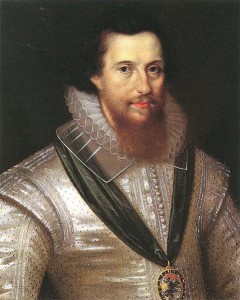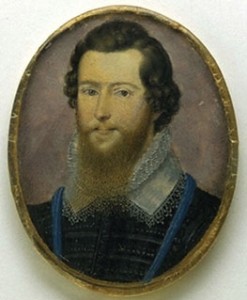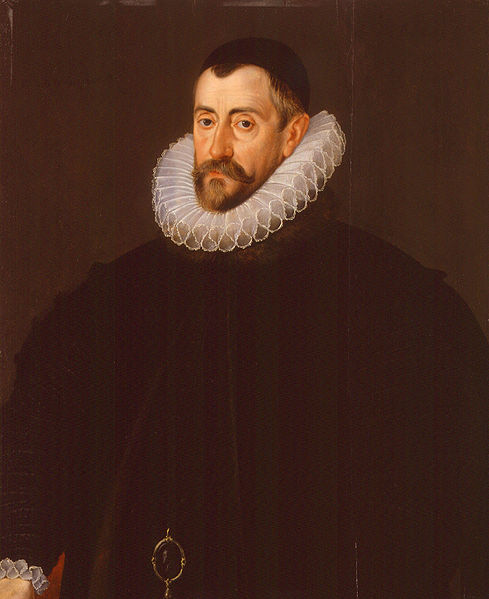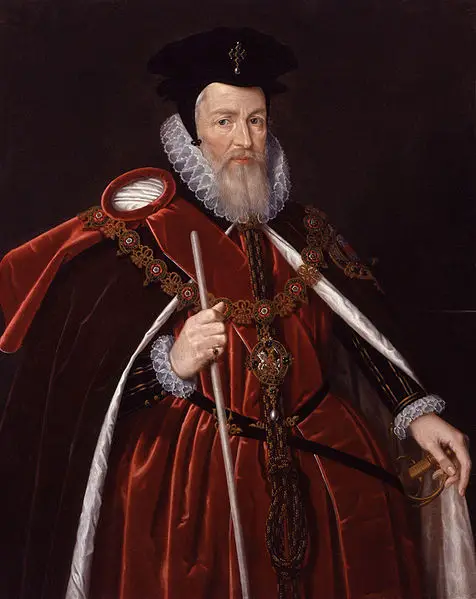
Robert Devereux, 2nd Earl of Essex, after Marcus Gheeraerts the Younger
Essex first caught the Queen's attention in 1584 when his stepfather, Leicester, brought him to court, and he was appointed Master of the Horse on his return to court after successful military service in the Netherlands with his stepfather. He was just twenty-one, and the Queen was fifty-three.
Although Robert Devereux is often described as "the darling of Elizabeth's old age", having replaced his stepfather in Elizabeth's affections after Dudley's death in 1588, Alison Plowden says that "it would probably be more accurate to describe him as one of its greatest headaches". Although Essex was dashing and charming, he was rash, ambitious, arrogant, headstrong and used to getting his own way. Unlike Dudley, Essex did not know Elizabeth as only a childhood friend or sweetheart can, and he constantly underestimated her and attempted to bully her into submission.
After a successful raid on Cadiz in 1596 during the war with Spain, Essex returned to England as a hero. His return to court caused the forming of two factions: the Devereux faction, who were seeking military profit and glory, and the opposing faction headed by Lord Burghley and his son, Robert Cecil, who were on the side of peace. Although Elizabeth loved flirting with the handsome Essex and doted on him, she sought to keep a balance between the factions, and would not always give her favourite what he wanted. This led to Essex sulking like a spoiled child, and to stormy rows between him and the Queen. Essex ignored the advice of friends like Francis Bacon, who warned him not to offend Elizabeth by seeking to be overly powerful, because he did not want to settle for 'just' being a servant like his stepfather. He wanted more. Wise counsel fell on deaf ears, and Elizabeth's attempts to tame wild-child Essex failed.
Ultimately, it was his pride and his need for recognition and power that led to his undoing. In 1599, Essex became Lord Lieutenant of Ireland, but his campaign against the Irish was unsuccessful. Essex constantly ignored the Queen's orders, acted contrary to her wishes and constantly worried about what the Cecil faction were getting up to back at court. His obsession with power led to him giving up on the Irish situation, making a truce with the Irish rebel leader (against the Queen's wishes) and returning to England without the Queen's permission. This amounted to desertion and disobedience, something which Elizabeth could not and would not tolerate. The situation was made worse on the 28th September 1599, by Essex striding into Elizabeth's bedchamber unannounced and seeing the Queen without her makeup or wig, without her "mask of youth".
On the 29th September, Essex was interrogated before the Queen's Council for around 5 hours, and the Council concluded that his truce with the Irish rebels was indefensible, and that his return to England was a desertion of duty. Essex was then put under house arrest. In June 1600, Essex appeared before a special court and was punished by being deprived of his public office and being confined to his home. However, in August, he was granted his freedom, although his sweet wines monopoly, his one source of income, was not renewed.
He may well have wormed his way back into the Queen's affections if he had apologised and appealed to the Queen for mercy - after all, she had a soft spot for him and was used to his impulsive behaviour - but Essex made the fatal mistake of trying to enlist the support of the Scottish king, James VI, against Cecil's faction at court, and planning a coup for March 1601 to force Elizabeth to summon Parliament and deal with Cecil and his faction. When, on the 7th February, Essex received a message from the Queen that he was to present himself before Council, he decided to move things forward and summoned three hundred followers, telling them that Cecil and Ralegh were planning to assassinate him, and that the rising should therefore take place the next day, instead of in March.

Robert Devereux by Isaac Oliver
On the 9th February, Elizabeth I told the French ambassador that the "shameless ingrate, had at last revealed what had long been in his mind". Her patience had been stretched beyond breaking point and she could no longer excuse her past favourite's behaviour. On the 13th February the full details of the coup planned by Essex were made public, and on the 17th February indictments were laid against Essex and his key supporters, including Henry Wriothesley, 4th Earl of Southampton. Two days later, on the 19th February, Robert Devereux, Earl of Essex, and his friend, Southampton, were tried at Westminster Hall by a jury of their peers. Both men were accused of high treason, found guilty and sentenced to death. Elizabeth I, in her mercy, commuted Southampton's sentence to life in prison and Essex's sentence of a traitor's death to death by beheading. On the 20th February, the Queen signed his death warrant.
Essex was executed on Tower Green on the 25th February 1601.
Taken from On this Day in Tudor History by Claire Ridgway.



Leave a Reply